

Home Page - Osprey Main Page - Migration Page - Birds of Prey
Migration 2013
It's here! Thanks to the brilliant computer gurus at Movebank.org, we are now presenting data in an interactive format. The map below shows where our birds tagged prior to this year (except our cell-tower birds Rammie and Bridger) are now. You can also see where they were at any given point in time. The map automatically (yes!) updates itself as new data are received from the satellites. Note: You can zoom in to see habitat details along the birds' paths. Hover the cursor over a point to see which bird is which. To follow the migration, either pick a date with the calendar up at the top of the map, or drag one of the birds' dots along its track. As you do that, you'll see all the other birds move to where they were at that time. Way cool! Watch the race between North Fork Bob and Sr. Bones.
Where's Waldo?
|
|
Our five Satellite-tagged birds from 2012 are on this map Bones=Red Art=Yellow Snowy=Green Bob=Magenta Belle=Blue Put the cursor on the yellow dot (Art) and slide him back to his wintering grounds. Then move him along his track to watch the timing of all the birds. Once he gets home, move the blue dot (Belle) along her track. Remember you can zoom in to see the details of the landscape our flock covered heading home. |
July 2, 2013 -
(updates to this narrative are highlighted in
blue)
Another spring migration is over,
as is a very busy trapping season during which I tagged 11 adult males.
Our 2 veterans (Sr. Bones and North Fork Bob) both
returned to their breeding grounds for the 3rd
time--a record for our telemetered birds). Bob
started his trip home on the 15th--5-6 days earlier than in previous years.
Bones started on the 19th, a day earlier than last year. They both got home on
April 4th--Bob a few hours before Bones. Proving there's no
end to surprising behavior from our tagged
birds, Bob got home to Long Island and didn't
even spend the night there. He crossed Long
Island Sound and spent some time in Connecticut!
In the three years we've followed him, he's
never been to Connecticut. He probably was at
one point (most likely as a juvenile) before we
tagged him. Bob has been hanging around the nest
pole he's been wanting to nest on for a couple
of years. There are other birds with the same
idea, however, so he's not going to get a chance
to nest this year.
Bridger, one of the two adult males from the Westport
River outfitted with cell-tower GSM
transmitters, rather miraculously found, on his
way south, a couple of cell towers deep in the
Amazon and sent us data for most of his travel
to those points. As he started north, he found
another tower in NW Brazilian Amazonia, so we
know what he did over the winter. But we haven't
heard from him since the 16th. By now it is
clear that something happened to him.
With these new transmitters, because we can go for a long time with no data, there's no way to tell what happened or where we
lost him.
We heard from his neighbor, Rammie, on 17 March--the
first signal from him since late September last year! So
we now also know where he spent the winter--in
northern Venezuela. He was the first of our birds to arrive at his nest this spring. On 1 April, he made it all the way from northeastern Maryland to the
Westport river--an impressive 310 mile sprint to get home. At that time, Alan Poole reported that 30-50% of the nests on the Westport River (Rammie's
home turf) have birds on them, so he doesn't seem to be too late in his return. That said, as of 2 May,
there were no eggs in his nest. He's there with
his female, so it's pretty strange that she
hasn't started to lay yet.
They did finally lay eggs,
but the nest failed for unknown reasons.
Our adult male from New
Hampshire, Bridgewater Art, settled down on the Tocantins River in northeastern
Brazil (which is south of the Amazon). This was the farthest any of our birds
have gone in that direction. He was one of three birds starting north on the
15th. He dilly-dallied for a few days before really getting going in full
migration mode on the 20th. He got home on April 10th, and was greeted by a TV
crew and reporters from several New Hampshire newspapers along with my colleague
in the New Hampshire tagging work, Iain MacLeod. He's busy
being a good Dad, taking his share of the
incubation duties when it's his turn--when his
mate is dining on a fish he brought home.
He is now feeding 3 healthy
young--a first for this nest!
Very surprisingly, Snowy, our juvenile from the class
of 2011, started north on the 23rd. This is by
far the earliest any of our juveniles have
started their first trip home. He even left
before Belle (Class of 2010), who just
started her second trip home from down on the
Rio Madeira. She's only our 4th juvenile to make
it back to its wintering area for a second time.
Snowy spent over a week in a
big marshy area on Cuba's north shore. He
finally got going, but overshot the turn to the
Florida Keys, so he wound up flying about 480
miles over the Gulf of Mexico from Cuba to the
Florida panhandle. The trip to the Keys would
have been about 130 miles!
Snowy returned to Martha's Vineyard on May 10th.
He quickly established a pattern of moving back
and forth between Cape Cod and the Vineyard. He
took a surprise trip up to Boston on June 26th
and is now a bit west of Boston.
Belle crossed the Caribbean successfully on the 6th.
She spent about a week at a big lake (Saumatre)
in eastern Haiti, and
is now back on Cape Cod. No more birds left in the Caribbean!
She got back to Cape Cod on April 26th. She's
mostly been on the Cape, but she's made 7 trips
over to Martha's Vineyard, where she is fishing
the same coves on Tisbury Great Pond as out two
newly tagged adult males.
Between April 23rd and May 17th I think I put about
1,500 miles on my car as I tagged adult males
from Stratford, NH, 20 miles from the Canadian
border, to Tangiers Island out in Chesapeake
Bay, about 525 miles south of the Stratford
nest. Seven of these transmitters are the new
cell-tower units, which give us GPS locations as
often as every 2 minutes. Yikes, that's a lot of
data!
-------------------------------------------------------------------------------------
Jump to links to maps, updates on old birds, and bios for this year's class.
Join the new Osprey Migration Google Group forum. (You'll get the updates and have a chance to comment on what the birds are doing. The more people who switch over to this option, the less work for me!)
Subscribe to the email "New Maps Alert" list.
Visit the Westport River Osprey website.
2013 Osprey cams
and links:
YouTube Video of trapping and tagging an
adult male on the Anacostia River in Washington,
DC, with D.C. Chief of Police Cathy Lanier as my
Osprey wrangler.
Dunrovin Guest Ranch - Lolo, Montana - High
quality (of course--it's through Cornell's nest
cam program). A rival to the Estonia cam. All
the chirping are House Sparrows, which nest in
the "basement" of many Osprey nests. They've
evolutionarily figured out that Ospreys don't
eat little birds and make great bouncers to keep
hawks that do eat little birds away. What a
deal!
Okoboji, Iowa - Great resolution on this
one! There's snow on the ground and in the nest
on 19 Apr-no eggs yet.
The
Dunedin,
FL, Osprey nest cam is up and running (and
they have their first egg!). It's fun because
you get to run the camera.
Hellgate Nest - Missoula, MT. Top quality
cam.
Hog Island, Maine - Great cam! Two growing
young (21 June) in the nest. This one's
especially cool because there's a camera
operator who zooms in and out when things happen
in the nest-sometimes at the request of a large
audience watching and texting to a message board.
On Fishers Island in Long Island Sound. From the Henry L. Ferguson Museum. Very sharp image. About a 2-sec refresh rate.
Blackwater National Wildlife Refuge in Cambridge, Maryland
Hilton Head Island, South Carolina - Good resolution, about 5 sec refresh rate
Ayer's Island - New Hampshire. We tagged young here in 2011 and Art stopped here before he arrived at his own nest! It's mayhem at this nest as 2 or 3 males are trying to take over the nest and they're kicking eggs out of the nest as fast as the female can lay them.
Montezuma Wildlife Refuge - New York (this one's pretty slow--images updated only every 30 seconds)
It's back on line! Believe it or not, the best Osprey cam I know of anywhere is in Estonia. Click here to watch the high-def action
Elsewhere across the Atlantic:
Rutland Water (England)
Finland 1
Finland 2
Finland 3
Really amazing videos of
Ospreys hunting.
Why Ospreys hate
Great-horned Owls.
------------------------------
Use these links to go straight to a bird's maps or bios. Names in hot pink are newly updated (11 March 2013). (Note-if you go to a bio for one of the birds tagged before 2012, you'll have to navigate back to this page).
| Belle | '10 Juvenile - Martha's Vineyard/MA | Bio - Map - Returned to Martha's Vineyard for the second time-a record for our juveniles. Updated 18 May |
| Snowy | '11 Young male tagged post fledging on the Chappaquiddick shores of Katama Bay. | Bio - Map - One of two healthy young at a nest that has not been very productive over the years. He's back home after his 18 month "gap year" in South America: Partially Updated 17 June. |
| Sr. Bones | '10 Adult male - Nantucket/MA | Bio - Map - Nest failed in 2010. In 2011 he fledged a youngster for the first time. He raised two young this year and is back in Nantucket for the 3rd time. Updated 11 Mar. |
| North Fork Bob | '10 Adult male - Mattituck, Long Island/NY. | Bio - Map - Bob is back on Long Island--still without a mate and nest. This is his third migration north since we tagged him. Updated 10 May. |
| Bridgewater Art | '12 Adult male - Pemigewasset River in Bridgewater, NH. | Bio - Map - Art is a male that we were unable to trap in 2011. In 2012 our new and improved nest trap was just what the doctor ordered. He's now home waiting for his eggs to hatch! Updated 18 Mar. |
| Bridger | '12 Adult male - East Branch, Westport River | Bio - Map - After months of radio silence, Bridger reported in on his way north in NW Brazil on 16 March. Bridger did not return from migration. We'll never know what happened to him. He's the only bird we lost this spring. Updated 17 Mar. |
| Rammie | '12 Adult male - East Branch, Westport River | Bio - Map - Updated 2 Apr. Rammie reported in from northernmost Colombia as he started north, so we know what he did on his winter vacation. He's back at his nest on the Westport River in SE Massachusetts. |
| New birds | ||
| Donovan | Adult male-Satellite transmitter | Bio - Map - Updated 18 May. Nests in Tilton, NH |
| DJ | Adult male-cell tower transmitter | Bio - Map - Updated through 12 June. Nests on Chappaquiddick Island, MA. |
| Edwin | Adult male-cell tower transmitter | Bio - Map - Updated 18 May. Nests Fishers Island, NY, at the mouth of Long Island Sound. |
| Icarius | Adult male-cell tower transmitter | Bio - Map - Updated 15 May. Nests on Chappaquiddick Island, MA. |
| Mackenzie | Adult male-Satellite transmitter | Bio - Map - Updated 23 May. Nests in Stratford, NH, on the Connecticut River. |
| Nick | Adult male-cell tower transmitter | Bio - Map - Updated ... Nests on Tangier Island in the Virginian waters of Chesapeake Bay. |
| Quin | Adult male-cell tower transmitter | Bio - Map - Updated ... Nests on Tangiers Island in the Virginian waters of Chesapeake Bay. |
| Rodney | Adult male-satellite transmitter | Bio - Map - Updated 25 May. Nests on the S. Capital St. Bridge over the Anacostia River in Washington, DC. |
| Ron Harper | Adult male-satellite transmitter | Bio - Map - Updated 25 May. Nests on the S. Capital St. Bridge over the Anacostia River in Washington, DC. |
| Tango | Adult male-cell tower transmitter | Bio - Map - Updated ... Nests on Tangiers Island in the Virginian waters of Chesapeake Bay |
| Woody | Adult male-cell tower transmitter | Bio - Map - Updated 30 May. Nests on Holly Beach Farm near the Annapolis Chesapeake Bay Bridge. |
Overview of our
Osprey research
This is the 14th year of our satellite
tracking and the 16th year that we have been
following the Osprey population on Martha's
Vineyard. The "we" here includes lots of friends
and colleagues, but most importantly Dick
Jennings. Dick "retired" to Martha's Vineyard
where he is probably busier now than he was when
he was earning a paycheck. He is a naturalist
for the Trustees of Reservations and my
right-hand man in all Vineyard Osprey trapping
and censuses.
At the end of the 2012 trapping season we had trapped
72 Ospreys and satellite tagged 49 of that total
(35 young and 14 adults). Over the 15 years of
our censuses, we've counted over 900 nesting attempts
and watched more than 1,000 young fledge!
Link
to details of our census work
Tagging new birds in 2013
Adults- It's shaping up to be a
very busy year! In the first wave of trapping
back in April, I tagged two adult males on the
Anacostia River in Washington, DC, 2 adult males
on Chesapeake Bay with GSM-cell tower
transmitters, and 2 adult males on Martha's
Vineyard. I've just deployed one GSM transmitter
on Fishers Island, 2 satellite transmitters in New
Hampshire and 2 more down on Tangiers Island in
the Virginian waters. If Bridger's female lays eggs, we'll
try to retrap him and move his transmitter over to
a new bird. We tried to get Sr. Bones'
transmitter back, but he was not interested in
our trap. Again. We've got one more approach,
but it looks like he's going to keep his
backpack. He's had it for three years with no
ill effects, so we're not worried about him.
Juveniles- 7 juveniles (Long
Island, Martha's Vineyard, coastal NH, and Essex, MA) are on
the calendar.
As 2013 began, we were down to seven surviving birds wintering down in South America--Sr. Bones and North Fork Bob (adult males) are both record setters on their 3rd winter carrying transmitters, Belle (juvenile from 2010), and Snowy (a juvenile from 2011) are heading north. It will be the second trip north for Belle and the first for Snowy. Bridgewater Art from New Hampshire was on the Rio Tocantins. Rammie and Bridger our cell-tower birds from the Westport River, MA, were hanging out under the radar. We didn't find out where they'd been until we got signals from them as they headed north in March. We only lost Bridger on the way north.
Who's Who - Bios of the Class of '13 (click on the name to go to the maps for that bird)
 |
"Tango" is an adult male trapped at a nest on Tangiers Island, out in Chesapeake Bay off the Virginia part of the Delmarva Peninsula on April the 23rd. He was caught first (typical of females), has more of a chest band than most males, and weighed in on the heavy side for males, so I wasn't sure if he was the male of this pair. That is, until we caught his mate, who tipped the scales at just over a kilogram (2.2 pounds), removing any doubt from our minds. She's about as big as they come. |
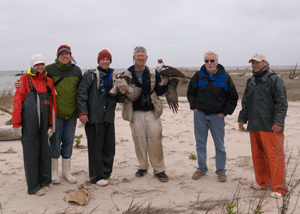 |
It was as cold a day as I've ever trapped on when we were down on Tangiers Island where we caught Tango (and his mate). The crew here includes folks from the Chesapeake Bay Foundation and Microwave Telemetry, who decided to use some of the new cell-tower transmitters on Ospreys as the basis for an educational outreach program with local schools. I gladly offered to trap and tag Ospreys for them. |
 |
"Woody" was trapped at the Holly Beach Farm near the Annapolis end of the Bay Bridge over the Chesapeake Bay on April 24th. |
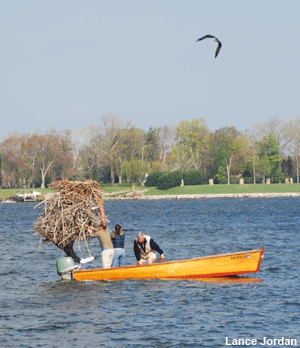 |
This was the first time I'd trapped at a nest out over the water. I didn't think the ladder we brought was going to be enough, but it was--barely! The pole supporting this nest has been gradually leaning farther and farther over every year, so it's now at about a 45-degree angle. The pair keeps leveling the nest each year, so it now looks like Dr. Seuss might have drawn it. |
| "Ron Harper" nests on a wooden pier off the East Capital St. Bridge over the Anacostia River. Three other pairs (including newly tagged Rodney) nest on the bridge. Ron's nest is in the shadows (when the sun is really low) of the National's baseball stadium. He was named in honor of the hard-working, devoted father of National's star Bryce Harper, in the expectation that Osprey Ron will do as good a job raising his kids as Ron Harper did. | |
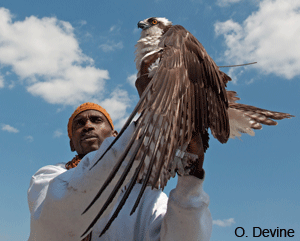 |
"Rodney"
is an adult male named for Rodney Stotts (seen
here holding Rodney the Osprey just prior to
release), a founding
member of the Earth Conservation Corps, where
Rodney found his love for raptors.
Rodney has devoted his life to engaging youth in
the restoration the Anacostia river. His new
effort, Wings over America, has sponsored the two
DC transmitters with Earth Conservation Corps.
Rodney works with the ECC to "empower our
endangered youth to reclaim the Anacostia River,
their communities, and their lives." Rodney's
experienced hand was a great help in tagging the
two Ospreys (Ron Harper and Rodney) tagged in DC this
spring. |
 |
"DJ" is an adult male named for my right-hand man, Dick Jennings, who found this pair nesting on the ground atop a sand dune on Chappaquiddick Island. They've upgraded their housing to a short pole out on the marsh near the dune they once (unsuccessfully) called home. Too many skunks patrolling the beaches to nest on the ground. That's the excuse we're using for him, although he hasn't raised young in the two nesting seasons since upgrading to a platform nest. The early data from his transmitter suggest that he's not a very good provider. His prolonged absences from the nest this spring are just what we saw from him in the past two years. |
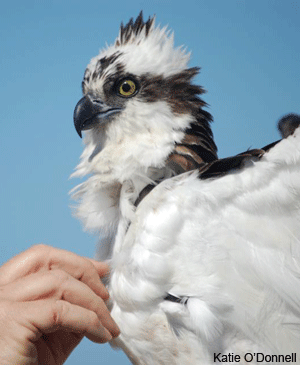 |
"Icarius"
is an adult male nesting near Homer's Pond on
Martha's Vineyard's south shore. I banded him
back in 2008 when we were capturing Homer. So,
he's at least 10 years old (he would have
been at least 4 when I banded him). We also trapped Penelope at this
very successful nest. We named him for
Penelope's father. To marry Penelope, Odysseus
had to beat Icarius in a foot race. He won.
Icarius is a proven male--his nest has always fledged healthy young. He got a cell-tower transmitter on May 1st. |
 |
"Edwin" is an adult male trapped at his nest near Beach Pond on Fishers Island, NY, on May 11th. Fishers Island is a skinny, 6-mile long island just a few miles south of southeastern Connecticut at the mouth of Long Island Sound. Edwin was named in honor of Edwin Horning, long-time island teacher and naturalist at the Henry L. Ferguson Museum, the Fishers Island institution that arranged funding for this cell-tower transmitter. |
 |
"Donovan" is an adult male, father of Jill and Chip, the two New Hampshire fledglings we tagged last summer. His nest is on the grounds of the massive J Jill distribution facility in Tilton, NH. We trapped him on May 13th. He was named for the Donovan Tree Experts, whose owner J. Dallas Worth generously spent two days driving their bucket truck around New Hampshire masterfully getting me up to our target nests. |
| "Mackenzie" is an adult male trapped at his nest on the east bank of the Connecticut River up in Stratford, NH, on May 14th. The nest is about 80 miles south of Canada and by far the farthest north of any bird I've tagged so far. He was named for Mackenzie Wrath, Donovan Tree Experts owner Dallas Wrath's daughter, so she can prove to her teachers that she was doing something educational when she played hooky that day. | |
| "Quin" is an adult male nesting at the Chesapeake Bay outpost on Port Isobel on Tangiers Island down in the Virginian section of Chesapeake Bay. He's the immediate neighbor of Tango, whom we tagged on April 23rd. Quin got his cell-tower transmitter on May 16th. He and his mate have a clutch of three eggs. | |
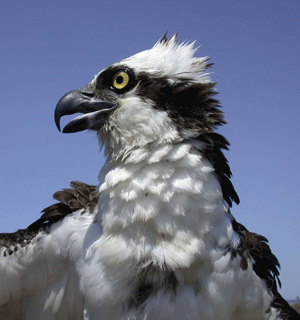 |
"Nick" is the last adult male I'll tag this year. We caught him at Port Isobel with very little time left in our day--in the Nick of time--before we had to get on the boat and head back to the mainland. We tagged him with a cell-tower transmitter on May 16th. His nest had 3 eggs. |